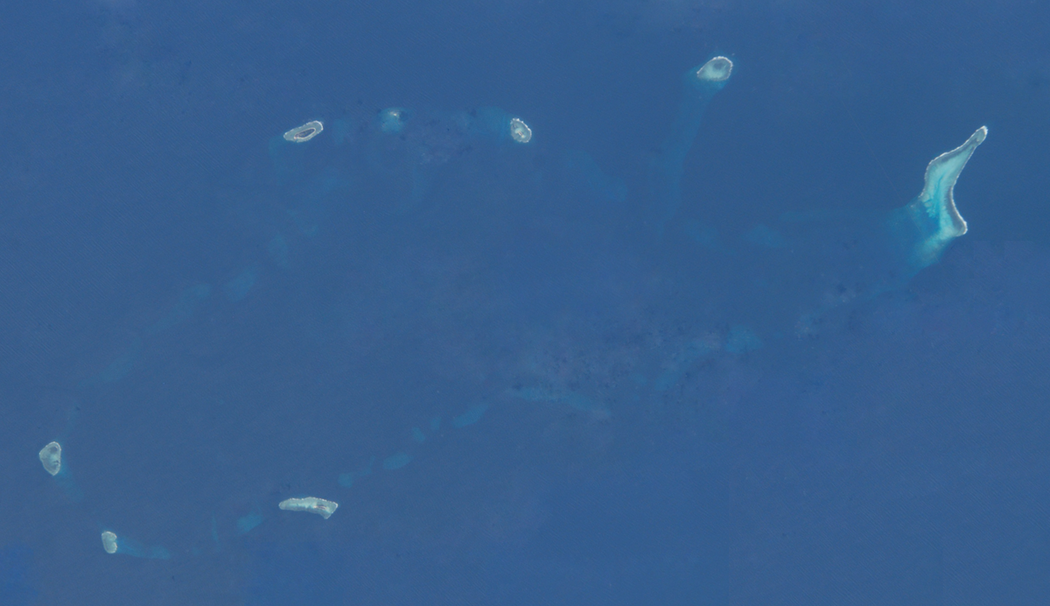الكاية الرملية
| island موضع نزاع | |
|---|---|
 Sand Cay | |
| أسماء أخرى | Đảo Sơn Ca (Vietnamese) Bailan Island (Philippine English) Pulo ng Bailan (Filipino) 敦謙沙洲 / 敦谦沙洲 Dūnqiān Shāzhōu (Chinese) |
| الجغرافيا | |
| الموقع | South China Sea |
| الإحداثيات | 10°22′30″N 114°28′48″E / 10.375°N 114.480°E |
| الأرخبيل | Spratly Islands |
| الإدارة | |
| District | Trường Sa District |
| Commune | Sinh Tồn Commune |
| تطالب بها | |
الكاية الرمليةSand Cay, also known as Bailan Island (فيليپينو: Pulo ng Bailan) and Son Ca Island (ڤيتنامية: Đảo Sơn Ca; Mandarin صينية: 敦謙沙洲/敦谦沙洲؛ پنين: Dūnqiān Shāzhōu�), is a cay on the north edge of the Tizard Bank of the Spratly Islands in the South China Sea. With an area of 7 hectares (17 acres), it is the ninth largest, and the fourth largest former Vietnamese-administered, of the Spratly Islands. The island has been occupied by Vietnam since 1974, (first by South Vietnam, then by the Socialist Republic of Vietnam after 1975). It is also claimed by China (PRC), the Philippines, Vietnam, and Taiwan (ROC).
. . . . . . . . . . . . . . . . . . . . . . . . . . . . . . . . . . . . . . . . . . . . . . . . . . . . . . . . . . . . . . . . . . . . . . . . . . . . . . . . . . . . . . . . . . . . . . . . . . . . . . . . . . . . . . . . . . . . . . . . . . . . . . . . . . . . . . . . . . . . . . . . . . . . . . . . . . . . . . . . . . . . . . . .
السيادة
The island has been occupied by Vietnam since 1974, (first by South Vietnam, then by the Socialist Republic of Vietnam after 1975). However, no Vietnamese stations have been built. By the later half of the 20th century, no nation had complete sovereignty on the islands.
الجغرافيا
Part of the Tizard Bank,[1] Sand Cay lies 6.2 nautical miles (11.5 km; 7.1 mi) east of Itu Aba Island, which is occupied by Taiwan. It is 450 metres (1,480 ft) long, 102 metres (335 ft) wide, and has an elevation of 3.5 metres (11 ft) to 3.8 metres (12 ft) at low tide.[2] There is a 41 metres (135 ft) high light house on the islet.[3] Sand Cay is commonly confused with Sandy Cay which is a sandy shoal (coral reef) near Thitu Island.
In 2022, news reports indicated that the Vietnamese government was engaged in dredging and landfill operations to expand the size of Sand Cay, Namyit Island, and Pearson Reef. The total area of the land reclaimed in these operations was estimated to be 170 hectares (420 acres). [4]
البيئة
Sand Cay has no source of natural fresh water, but the islet's coral sand is covered with a thin layer of fertile humus mixing with guano. The vegetation mainly composes of Barringtonia asiatica, Ipomoea pes-caprae and Casuarinaceae's species as well as some kinds of grass.[2] In recent years, islanders have cultivated fruit trees such as pomelo, jackfruit, dragonfruit, sugar-apple and guava.[5] Sand Cay is usually visited by seabirds, and its surrounding water is rich with fish, sea snails and sea cucumbers.[2]
انظر أيضاً
- سور الرمال العظيم
- List of maritime features in the Spratly Islands
- Spratly Islands dispute
- Truong Sa District
المراجع
- ^ "Digital Gazetter of Spratly Islands". Archived from the original on 2010-08-27. Retrieved 2008-03-22.
- ^ (in ڤيتنامية)Phạm Thanh Hà; Lưu Phương Mai (May 9, 2011). "Kí sự Trường Sa - kì 3: Nơi anh đến là biển xa..." Nhân dân online. Retrieved March 22, 2013.
{{cite news}}: CS1 maint: multiple names: authors list (link) - ^ "Vietnam carries out 'substantial' expansion in South China Sea, US thinktank finds". The Guardian. December 14, 2022. Retrieved July 3, 2023.
- ^ (in ڤيتنامية) Nguyễn Đình Quân (December 27, 2011). "Sơn Ca Xanh". Tiền phong online. Retrieved March 22, 2013.
وصلات خارجية
- Pages using gadget WikiMiniAtlas
- Articles with ڤيتنامية-language sources (vi)
- Short description is different from Wikidata
- Coordinates on Wikidata
- Articles containing فيليپينو-language text
- Pages using Lang-xx templates
- Articles containing ڤيتنامية-language text
- مقالات تحتوي نصوصاً باللغة الصينية
- Islands of the Spratly Islands
- Tizard Bank
- Disputed islands
![Sand Cay is located in [جزر سپراتلي]](/w/images/thumb/4/4b/Spratly_Islands_relief_location_map.svg/260px-Spratly_Islands_relief_location_map.svg.png)

